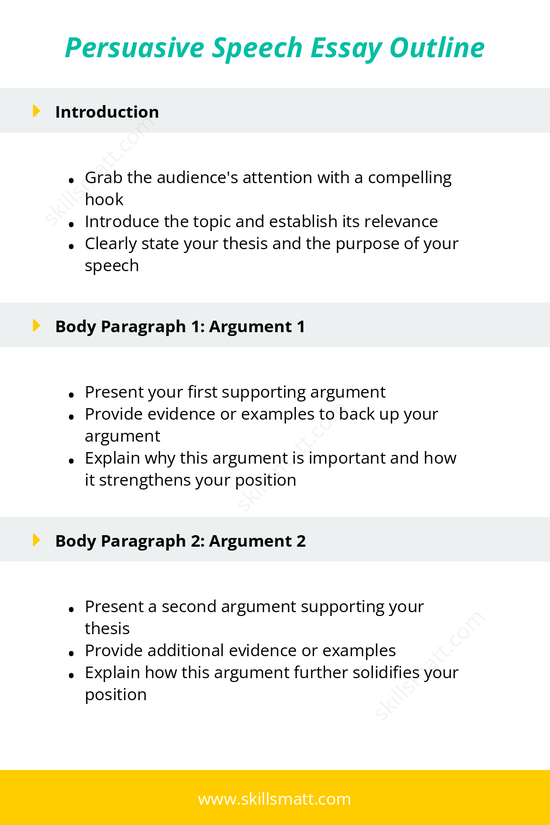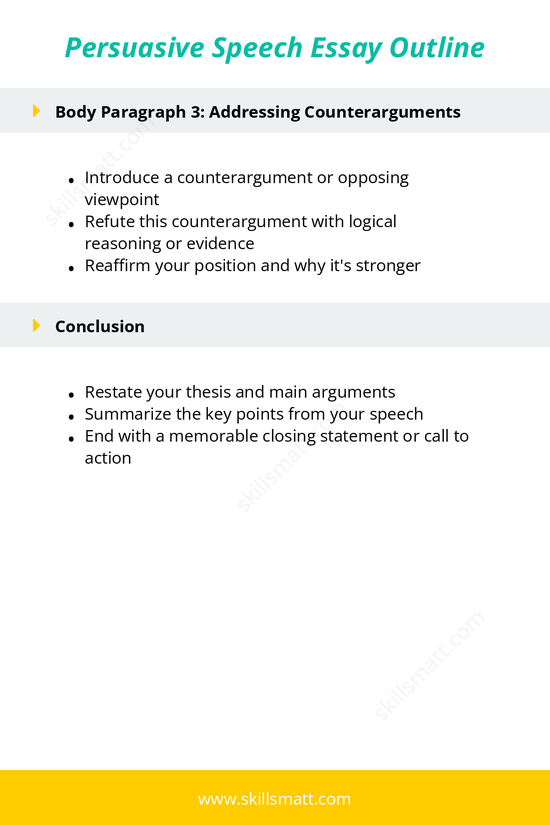Crafting a persuasive speech involves not only presenting your opinion but also convincing your audience through logic, emotion, and evidence. The outline provided below is designed to help you structure a persuasive speech effectively, whether for a class assignment, a public debate, or any other situation where you need to persuade others to adopt your viewpoint.
Introduction
The introduction of your speech sets the tone for the rest of your argument. It’s your opportunity to grab the audience's attention and clearly state your thesis.
- Grab the audience's attention with a compelling hook: Start with a powerful opening that captures interest. This could be an intriguing question, a shocking fact, or a relevant quote.
- Introduce the topic and establish its relevance: Briefly explain the issue or topic you will be discussing. Make sure the audience understands why this topic is important and why they should care.
- Clearly state your thesis and the purpose of your speech: End the introduction with a clear and concise thesis statement that outlines your position on the issue. This sets the stage for your arguments and signals the purpose of your speech.
Body Paragraph 1: Argument 1
The first body paragraph presents your strongest argument in support of your thesis. This is the first reason why your position is valid and important.
- Present your first supporting argument: Begin by clearly stating the first reason why your thesis is true. Make it relevant and impactful to the audience.
- Provide evidence or examples to back up your argument: Support your argument with facts, statistics, or real-life examples that are credible and persuasive.
- Explain why this argument is important and how it strengthens your position: After presenting the evidence, explain its significance and show how it supports your thesis. Make sure to highlight why this argument is compelling to the audience.
Body Paragraph 2: Argument 2
The second body paragraph introduces another supporting argument, building upon the first. This second argument should further validate your position.
- Present a second argument supporting your thesis: Present another strong reason in favor of your position, making it distinct but related to your first argument.
- Provide additional evidence or examples: Just as with the first argument, provide credible evidence, studies, or personal anecdotes to back up this argument.
- Explain how this argument further solidifies your position: Tie the evidence back to your thesis and explain why this second argument strengthens your overall case.
Body Paragraph 3: Addressing Counterarguments
In this section, you acknowledge the opposing viewpoint, refute it with logic, and demonstrate why your argument remains the stronger position.
- Introduce a counterargument or opposing viewpoint: Present a reasonable counterargument that someone who disagrees with you might raise. This shows you have considered other perspectives.
- Refute this counterargument with logical reasoning or evidence: Use logic and evidence to challenge the opposing viewpoint. This is your opportunity to show why their argument is less valid or compelling than yours.
- Reaffirm your position and why it's stronger: After refuting the counterargument, reinforce your own thesis and explain why it remains stronger despite the opposing viewpoint.
Conclusion
The conclusion of your persuasive speech is crucial. It’s your final chance to leave a lasting impression on the audience and solidify your argument in their minds.
- Restate your thesis and main arguments: Summarize your thesis and the key points you’ve made in your speech. This reminds the audience of your position and why it’s valid.
- Summarize the key points from your speech: Briefly review the main arguments and evidence you presented. This helps reinforce your message.
- End with a memorable closing statement or call to action: Finish with a powerful statement or a call to action. You might encourage your audience to take action, change their perspective, or reflect on the importance of the topic.
By following this persuasive speech outline, you’ll be able to present a well-structured, convincing argument that captures your audience's attention and persuades them to adopt your point of view. Effective speeches not only present strong arguments but also engage and motivate the audience to think or act differently about an issue.


